
Rust vs C++: Successor or Pretender? Honest Opinion of our CTO
As systems grow more complex and reliability becomes mission-critical, developers face an old but still unsolved dilemma: should you build […]

Testing embedded software isn’t just about verifying code; it requires a combination of methodologies and tools to address the hardware dependencies, performance concerns and strict regulations these systems face. Whether it’s a medical device, an automotive ECU or a smart home appliance, thorough testing ensures these systems meet safety, security and performance standards.
This guide will help you:
Need help with your embedded systems development project?
Let’s talk about how our team can support your development goals and technical challenges.
Embedded software testing is the process of verifying that the software running on dedicated hardware devices works correctly, safely and reliably under all expected conditions. Unlike standard app or PC software, embedded programs often run in real-time with limited memory and processing power and interact directly with sensors, actuators and specialized hardware. This makes testing both more critical and more complex than in traditional software development.
In practice, embedded testing means exercising the code to ensure it behaves as expected in all scenarios – from normal operation to edge cases like power failures or high load.
For example, an embedded test might simulate a sudden loss of sensor input or a spike in temperature to verify the device responds safely. Because embedded systems are often part of larger physical products (cars, appliances, industrial machines etc.), testing also checks that the software and hardware and software components interact properly as a complete system.
Security testing is also crucial for embedded systems, especially those in industries like healthcare, automotive and IoT. These systems need to be tested for potential vulnerabilities that could compromise data integrity, user privacy and system stability. Ensuring embedded software is resilient against cyber threats is part of the validation process.
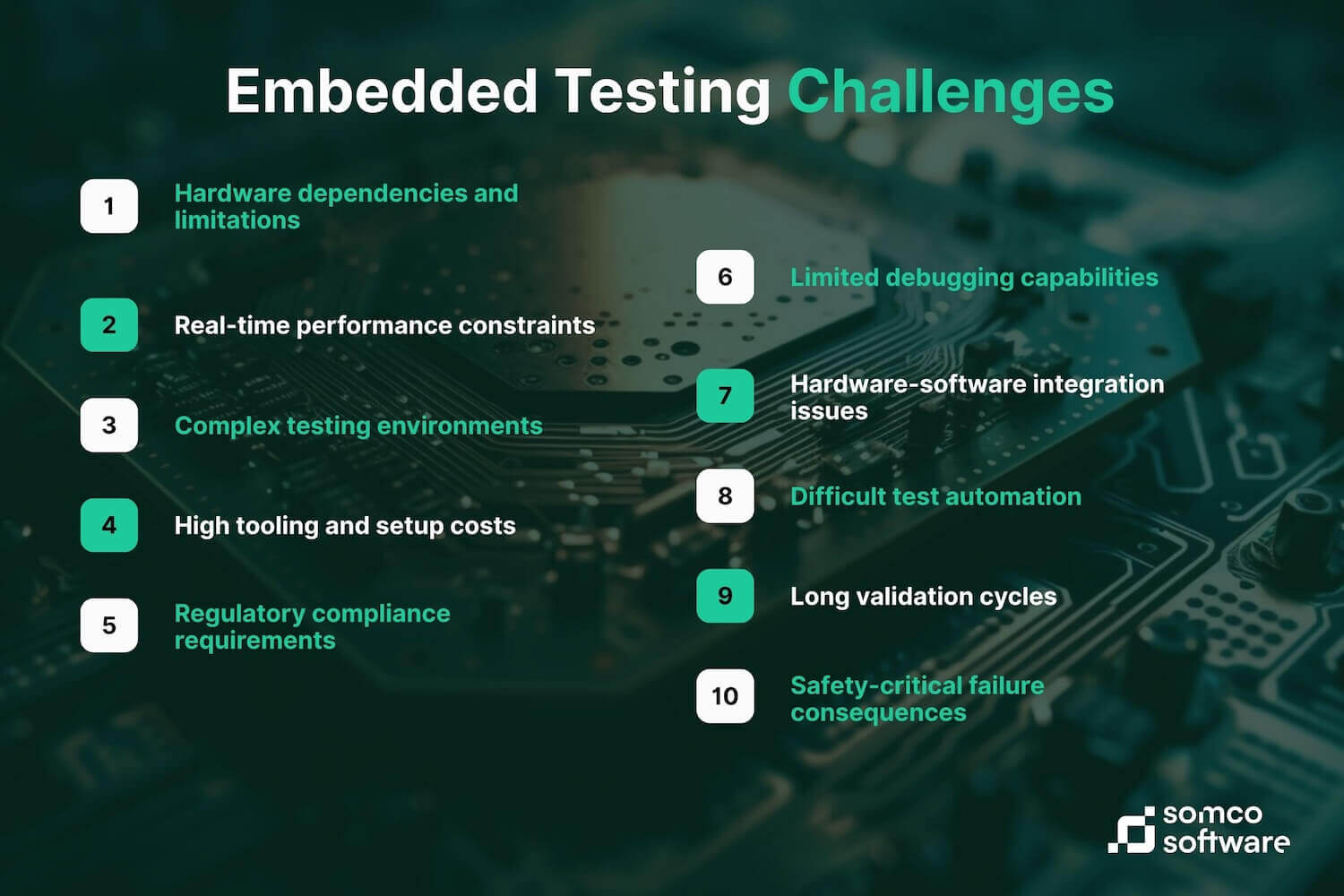
At first glance, software testing principles — plan, execute, verify — look similar whether you’re testing a web app or an engine control unit. But in practice, embedded software testing has some key differences that affect cost, timelines and the skillset required:
| Aspect | Traditional Software Testing | Embedded Software Testing |
|---|---|---|
| Execution Environment | Runs on general-purpose hardware (PCs, servers, cloud) with standard OS. | Runs on custom hardware with limited CPU, memory, and storage — sometimes with no OS or a small Real Time Operating System (RTOS), making the hardware environment itself a crucial testing factor. |
| Dependencies | Easy to mock or virtualize dependencies (e.g., database, APIs). | Deeply tied to physical sensors, actuators, and hardware buses — often requiring hardware-in-the-loop setups. |
| Performance Constraints | Often measured in seconds or milliseconds, with some flexibility. | Must meet strict real-time deadlines; a delay of a few ms can cause a functional failure. |
| Failure Impact | Bugs can frustrate users or lose data, but usually don’t threaten safety. | Failures can cause physical damage, safety hazards, or regulatory non-compliance. |
| Tooling | Abundant off-the-shelf testing tools; mature automation ecosystems. | Specialized embedded testing tools (VectorCAST, Squish for Qt, HIL simulators) and hardware rigs required. |
| Deployment | Easy to roll back or hot-fix via updates. | Fixes often require physical access to devices or firmware re-flashing — making prevention far more valuable. |
Embedded testing involves multiple layers of methodology, from unit and integration tests up to system testing and performance testing of the final solution.
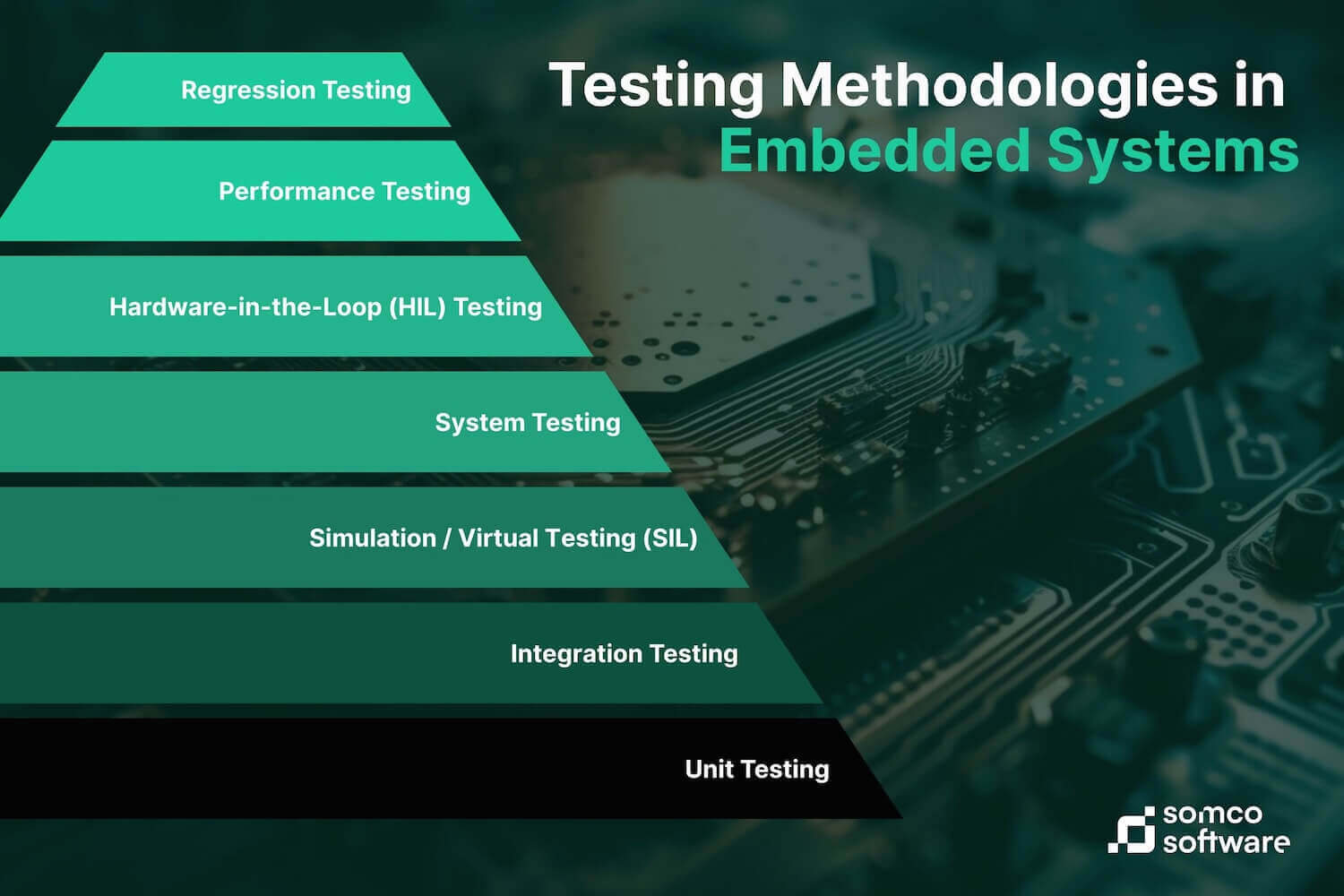
Unit testing focuses on the smallest testable pieces of software – typically individual functions or modules in the embedded code. The goal is to verify each component’s logic in isolation, ensuring it produces the expected outputs for given inputs.
For example, engineers might write unit tests to check a sensor calibration function or a PID control algorithm under various scenarios. Unit tests are usually run on a host computer (not on the embedded device itself) using frameworks such as CppUTest or Unity in C/C++ development. By measuring various code coverage metrics, developers can ensure that all relevant paths in the code are tested, providing valuable insights into test effectiveness. These metrics include statement coverage, branch coverage and path coverage, each contributing to a more thorough testing strategy. By running these tests on a PC, developers can quickly iterate and catch logic errors early, before the code is ever loaded onto the target device.
The challenge in embedded unit testing is often simulating or mocking hardware dependencies – for instance, faking a sensor reading or a communication interface so that the function can be tested in isolation.
But with careful design (e.g. using abstraction layers), even low-level embedded code can achieve good white box testing coverage.
Another important methodology is black box testing, which involves testing the system’s functionality based solely on inputs and outputs, without knowledge of the internal workings. This testing approach is especially useful for validating system behavior and performance in real-world scenarios, ensuring that the system meets its requirements even if the code structure is unknown.
While unit tests cover components in isolation, integration testing checks that modules work together correctly once integrated. In an embedded system, different software components (and sometimes initial hardware components) are combined and tested as a group.
For example, after unit-testing a sensor driver and a control algorithm separately, integration testing would ensure that when the sensor feeds data to the algorithm in the firmware, the overall behavior is correct. These tests often still run on a host machine or an emulator, using dummy inputs to simulate how multiple parts of the software interact. Key focus areas include interface mismatches, data flow between modules and any resource conflicts (like two tasks vying for the same hardware resource).
Integration tests might simulate sequences such as “sensor triggers -> data is read -> decision logic runs -> actuator command is issued” to validate that all steps work in harmony. The main challenge here is handling dependencies and timing – ensuring that the integrated software components communicate properly under realistic conditions. By catching issues at this intermediate stage, integration testing prevents costly late-stage surprises when the full system is assembled.
As the software validation progresses, one reaches a point where testing must involve real hardware to be meaningful. Hardware-in-the-loop (HIL) testing is a specialized methodology where the embedded software (often running on the actual target microcontroller or an evaluation board) is connected to a test setup that simulates the real-world signals and devices around it.
In essence, a HIL test rig acts as a virtual environment that feeds the device under test with lifelike sensor inputs, electrical signals and even faults, while capturing its outputs for verification. This allows engineers to exercise the software as if it were in the real product, but in a controlled lab setting.
HIL testing is essential for embedded systems that interact with complex or dangerous environments. For example, an automotive Electronic Control Unit (ECU) that manages engine throttle or braking.
Using HIL, testers can simulate a wide range of driving conditions (speeds, temperatures, sensor failures, etc.) and verify the ECU’s responses without needing a real car on a test track. The HIL simulator provides real-time inputs (like fluctuating sensor voltages or CAN bus messages) and verifies that the device’s outputs (to motors, valves, etc.) are correct.
One key advantage of HIL is the ability to create repeatable, automated testing scenarios – engineers can run the same test sequence over and over with exact timing, something impossible to guarantee in a live field test. This repeatability makes it easier to catch intermittent bugs and to test edge cases (e.g. a sensor reading spiking to an extreme value) reliably.
HIL setups often include scripting interfaces so that a whole suite of tests can run unattended, for example, overnight as part of a regression test cycle. In short, hardware-in-the-loop provides the closest thing to a “virtual proving ground” for embedded software, marrying the software with simulated hardware to ensure they work together under real-world conditions.
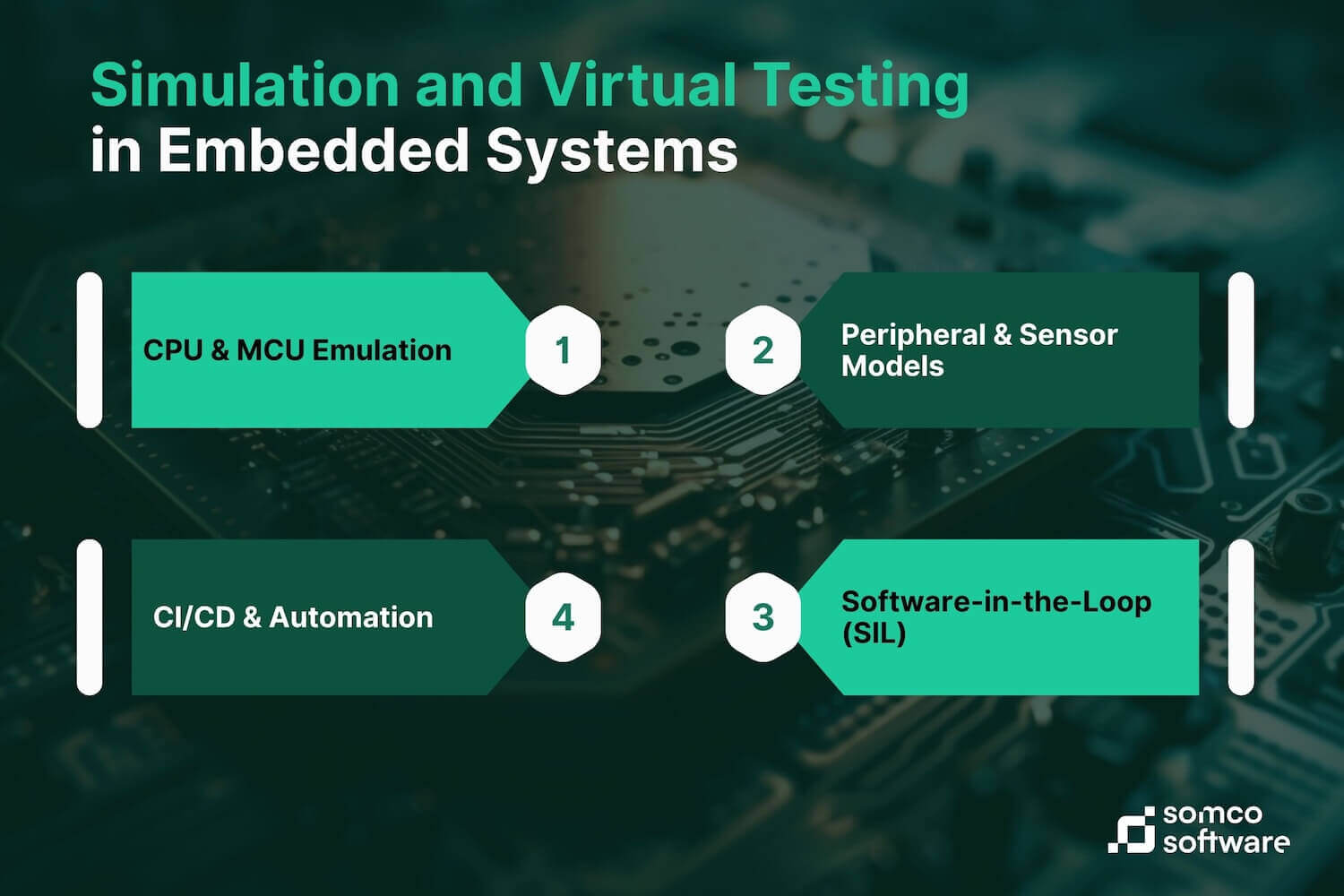
In embedded development, testing sometimes needs to start even before physical hardware is available, or cover scenarios that are hard to reproduce with real devices. This is where simulation and virtual testing come in. Engineers use software models and emulators to create a virtual environment for the embedded code. For example, CPU emulators like QEMU can mimic many microcontroller architectures (ARM Cortex-M, RISC-V, etc.), allowing teams to boot their firmware in a PC environment as if it were running on the actual chip. This means you can execute and debug the embedded software on your computer, stepping through code or running functional testing long before the actual hardware is ready.
Simulation isn’t limited to the processor: models can simulate peripheral devices and sensors as well. Tools can simulate analog inputs (ADC readings), digital signals on GPIO pins, communication buses (like feeding CAN messages or I²C traffic), and more. These simulations are typically executed with the help of an embedded testing tool, which enables automated runs and integration into CI/CD workflows. For instance, a team could simulate a temperature sensor’s behavior over time to test how their thermostat controller code responds, or simulate network traffic to test an IoT device’s communication stack.
Another strategy is Software-in-the-Loop (SIL), where part of the system (say, control algorithms) runs as normal software on a PC, but interacts with models of the hardware or environment. SIL testing allows faster iteration because it bypasses some hardware speed or availability limitations. The benefit of these virtual methods is speed and convenience: one can run thousands of test cases quickly, use powerful debugging tools, and even incorporate these tests into continuous integration pipelines.
However, it’s important to note that simulations are only as good as the models – they simplify reality. Thus, while simulation catches many issues early, final validation on real hardware is irreplaceable because subtle hardware timing, electrical noise, and real-world randomness can all affect the software. In practice, teams use a combination: they iron out most bugs in simulation, then perform HIL and on-device tests to finalize the software.
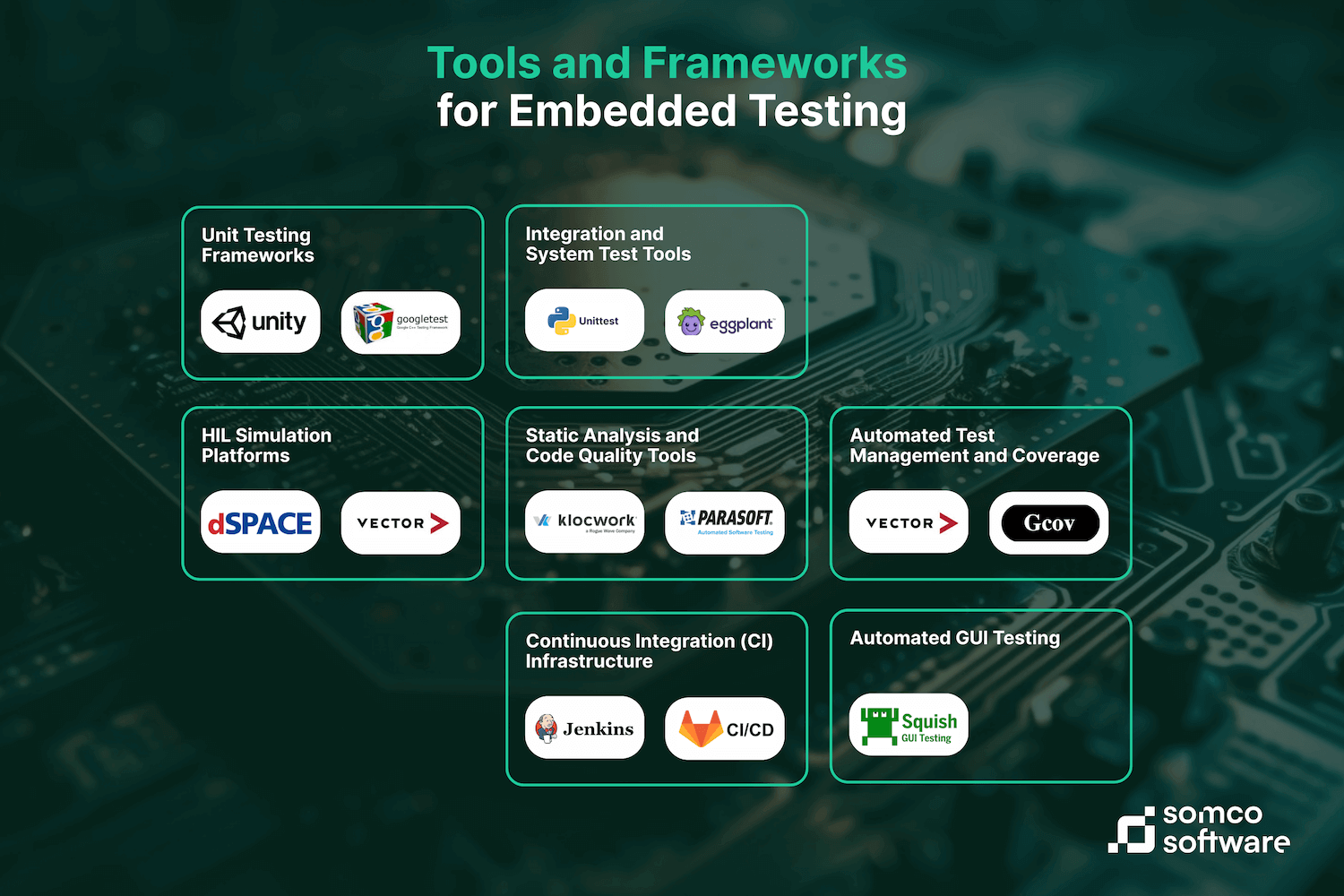
To thoroughly test embedded software, engineers use a mix of specialized tools and techniques. Here are some of the popular frameworks and methods used in embedded testing.
Choosing the right embedded testing tool also depends on its usability and ease of automation, which directly influence testing efficiency.
| Category | Description | Examples |
| Unit Testing Frameworks | Helps developers write and run tests for individual code units. | Unity, CppUTest, Google Test, TESSY |
| Integration and System Test Tools | Tools used to verify interactions between software components. | Python-based frameworks, Robot Framework, Eggplant |
| HIL Simulation Platforms | Simulates real-world scenarios and tests software in real-time. | dSPACE, National Instruments, Vector CANoe, Renode |
| Static Analysis and Code Quality Tools | Catches errors early in development through static analysis. | Klocwork, Parasoft, MISRA C |
| Automated Test Management and Coverage | Integrates static analysis, unit test results, and coverage metrics. | Parasoft DTP, VectorCAST, gcov |
| Continuous Integration (CI) Infrastructure | Automates the build, test, and deployment process for embedded systems. | Jenkins, GitLab CI, Azure DevOps |
| Automated GUI Testing | Focuses on automating the testing of graphical user interfaces (GUIs) in embedded systems. | Squish |
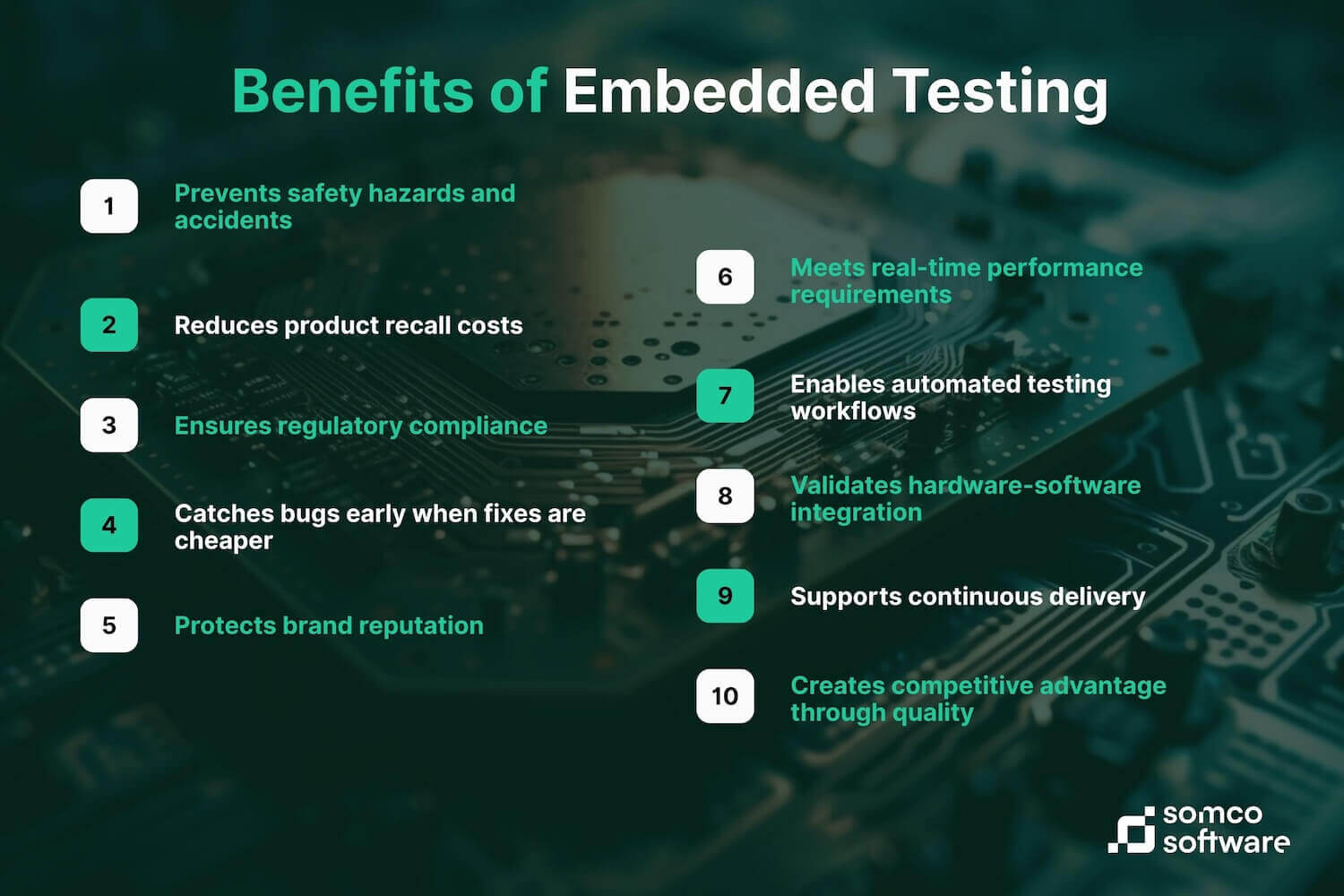
Because the stakes – both human and financial – are incredibly high. A faulty embedded system can lead to product recalls, brand damage, regulatory penalties or even loss of life in the worst cases. Below we show how rigorous testing translates to business value and risk mitigation in several sectors:
In the medical device industry, embedded software often touches human lives. Products like insulin pumps, pacemakers, defibrillators, infusion pumps and surgical robots rely on embedded code to function correctly. A software error in such devices can harm or kill a patient, leading to serious ethical, legal and financial consequences for the manufacturer.
For medical device companies, testing and validation (often documented as part of regulatory compliance like IEC 62304 for software lifecycle processes) is mandatory to get approvals to market and to protect patients.
Read more in our article: Medical Device Software Testing: Standards, Strategies, and Tools
The aerospace industry has long understood the importance of testing – after all, lives depend on the absolute reliability of flight control software. Avionics software goes through strict certification (per standards like DO-178C) which requires thorough testing, code coverage analysis and traceability of tests to requirements.
Modern cars have dozens of embedded computers (ECUs) controlling everything from engine timing to braking and airbag deployment. A software bug in any of these critical systems can have severe consequences.
Automakers known for reliability (a result of thorough testing regimes) build trust with their brand. Moreover, safety standards like ISO 26262 in automotive require evidence of extensive testing and validation for any safety-critical code.
Embedded software isn’t just in mission-critical systems; it’s also what makes your smartphone, smart TV or wearable gadget work. In the consumer electronics space, the challenges are about scale (millions of users), variability (users will do unexpected things) and fast product cycles.
Testing in consumer electronics focuses on delivering a smooth user experience out-of-the-box and over the product’s life via updates. Companies use techniques like beta testing, automated UI testing and compatibility testing. Continuous integration is used here too as products get frequent firmware updates.
In addition to automation, usability testing plays a role here to ensure end users experience intuitive and reliable behavior in everyday scenarios.
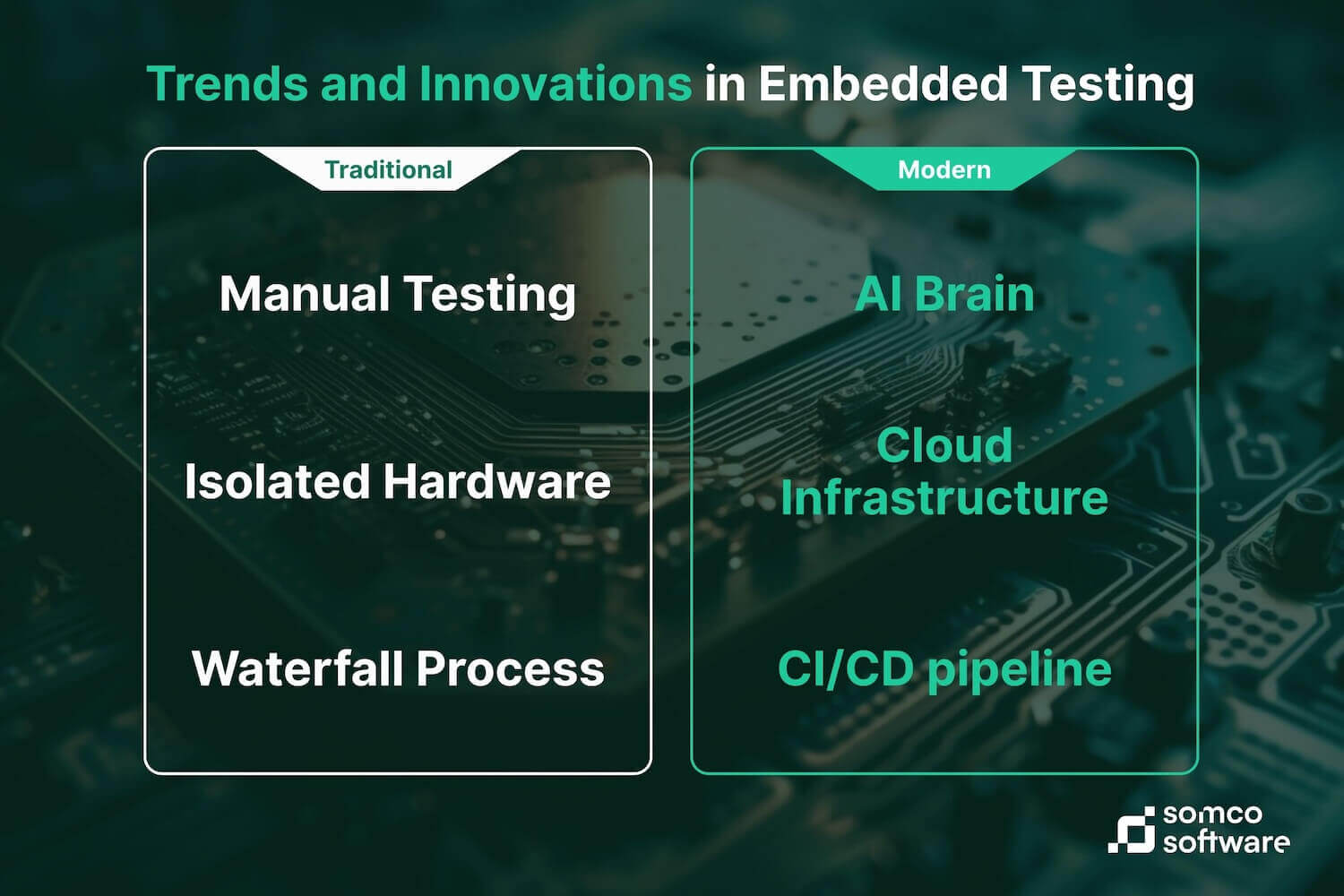
The landscape of embedded software testing is evolving driven by technological advancements and the need to deliver products faster. Two major trends making waves are the adoption of AI-driven testing techniques and CI/CD (Continuous Integration/Continuous Deployment) pipelines in embedded development.
In addition, the industry is embracing practices like “shift-left” testing (testing earlier in the development cycle), using cloud for testing and addressing new challenges from emerging tech (like machine learning components in embedded systems). Let’s explore these trends:
Artificial intelligence (AI) and machine learning are starting to influence how we test software. The promise of AI in testing is to augment and automate test design, execution and analysis. In embedded systems, AI-driven testing might mean using machine learning algorithms to generate test cases, intelligently explore input combinations or detect anomalies.
Continuous Integration and Continuous Deployment (CI/CD) practices have transformed web and mobile app development, enabling rapid incremental releases. Now the embedded world is adopting these DevOps practices to get faster and more reliable firmware releases. Traditionally, embedded software development was slowed down by hardware availability and manual testing, but that’s changing. Teams are setting up automated CI pipelines that build and test embedded code on every commit. A typical pipeline will compile the firmware (often for multiple target hardware configurations), run unit and integration tests on a host simulator and even flash the code onto actual hardware for further testing.
For a deep dive into CI/CD for Embedded see our article: Continuous Integration for Embedded Systems
Beyond AI and CI/CD, other innovations are emerging in embedded testing. Shift-left testing is one: organizations are testing earlier in the development process, e.g. requirements-based testing and simulations even as the hardware and software are being designed. The idea is to find defects as early as possible when they are cheapest to fix.
Another trend is cloud-based testing environments. Instead of relying solely on physical labs, companies are simulating devices in the cloud.
Embedded software testing may sound technical, but its impact is very real: it’s about making sure the devices and products your company builds will work perfectly and safely in the hands of customers. Whether it’s an automotive system preventing an accident or an IoT device protecting someone’s home, testing is what gives you confidence in the software. It’s an investment in quality that protects your product’s reputation and user trust.
That means adopting new tools and practices or partnering with external experts who can bring their expertise to your project. Either way the goal is the same: to deliver a robust, reliable whole embedded system that meets all requirements and delights (and protects) its users.
Need help with embedded software testing?
Let’s talk about how our team can support your development goals and technical challenges.
Let's face it? It is a challenge to get top Qt QML developers on board. Help yourself and start the collaboration with Somco Software - real experts in Qt C++ framework.
Discover our capabilities
As systems grow more complex and reliability becomes mission-critical, developers face an old but still unsolved dilemma: should you build […]
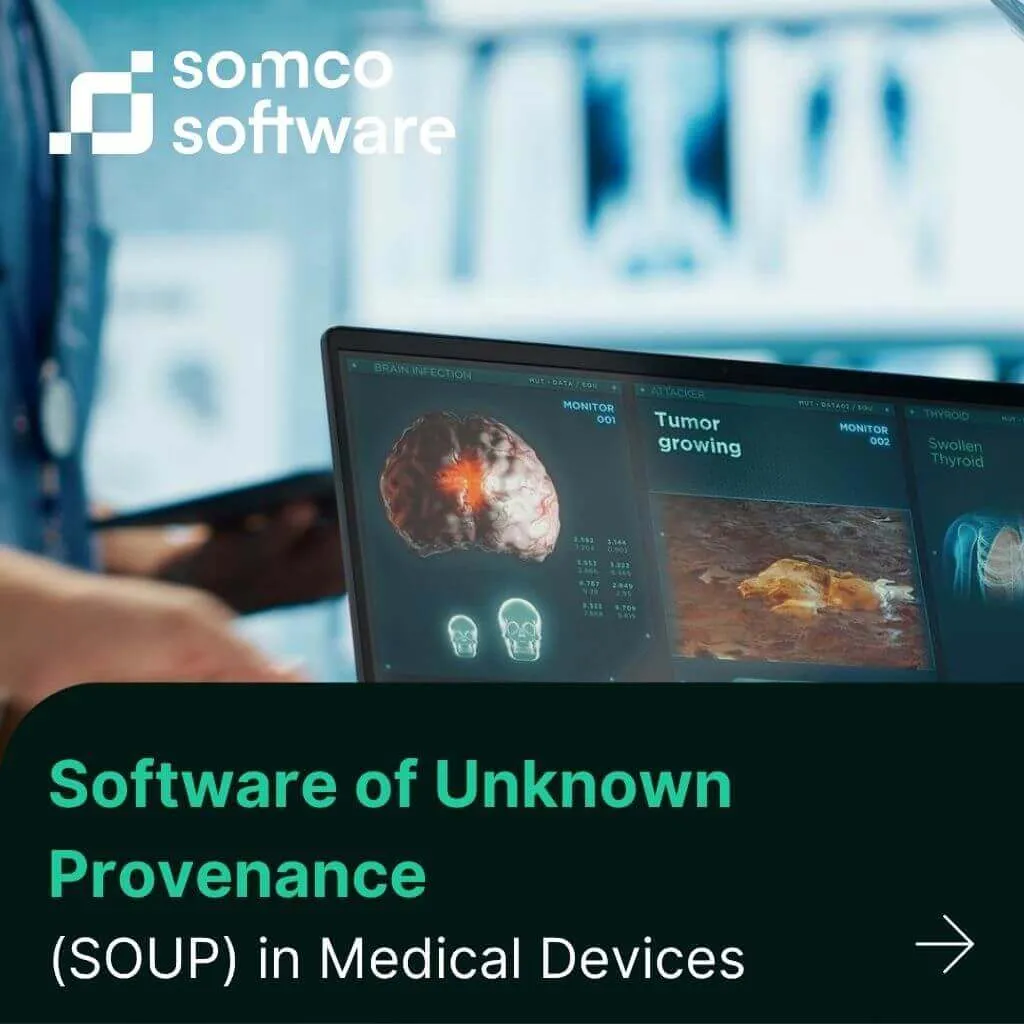
In the projects we deliver at Somco for medical device manufacturers, the topic of SOUP almost always comes up. Whether […]

As applications get more complex and performance expectations rise, multithreading becomes essential. In my experience, Qt provides a powerful — […]